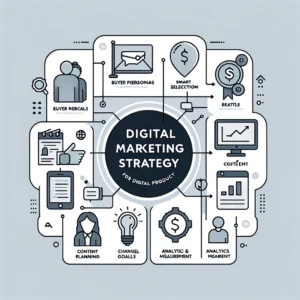Introduction to Market Research and Analysis

Understanding the Core Concepts of Market Research and Analysis
Market research and analysis form the bedrock of informed business decisions. This comprehensive process involves the collection, analysis, and interpretation of data regarding markets, encompassing customer behavior, competitor activities, and industry trends. For businesses at any stage, understanding these elements is crucial to developing effective strategies in product development, marketing, and sales. In an environment where markets are constantly evolving, staying abreast of these changes through market research is not just beneficial—it’s essential.
At the intermediate level, individuals are expected to have a grasp of basic market research concepts and are ready to delve deeper into more complex analytical techniques and interpretations. This guide aims to build upon that foundational knowledge, expanding into the nuanced aspects of market research and analysis. We will explore advanced methods of gathering data, sophisticated analysis techniques, and how to translate this information into actionable business strategies.
The Importance in Today’s Business Environment
In today’s dynamic business landscape, the importance of market research and analysis cannot be overstated. With ever-changing consumer preferences and intense competition, businesses must have a pulse on the market to stay competitive. Market research provides invaluable insights into what customers want, how they behave, and where the market is headed. These insights help businesses tailor their products, marketing strategies, and sales efforts to meet the market’s needs effectively.
Moreover, market research helps in identifying new market opportunities and potential areas of growth. It allows businesses to make data-driven decisions, reducing risks and increasing the chances of success. In essence, market research and analysis enable businesses to navigate the complexities of the market with confidence and precision.
The Process of Market Research

Identifying Your Target Market
The first step in effective market research is identifying your target market. This involves understanding who your potential customers are, what they need, and what drives their purchasing decisions. To do this, gather demographic information such as age, gender, income level, education, occupation, and location. It’s also vital to understand their psychographics, including interests, values, lifestyles, and behaviors.
Answering key questions about your market is crucial:
- Demand: Is there a genuine need or desire for your product or service?
- Market Size: How large is the potential market for your offering?
- Economic Indicators: What are the income levels, employment rates, and other economic factors affecting your market?
- Location: Where are your potential customers located, and how can your business reach them?
- Market Saturation: What is the level of competition, and how many similar products or services are available?
Understanding these aspects helps in creating a clear picture of your target market, enabling you to tailor your offerings and marketing strategies effectively.
Gathering and Analyzing Data
After identifying your target market, the next step is to gather relevant data. This can include primary research, like surveys, interviews, and focus groups, or secondary research, which involves analyzing existing data from reports, studies, and online resources. The goal is to collect comprehensive and accurate information to inform your business decisions.
Once you have gathered the data, the next step is analysis. This involves examining the data to identify patterns, trends, and insights. Data analysis can reveal customer preferences, market trends, and gaps in the market that your business can exploit. It requires a combination of analytical skills and industry knowledge to interpret the data correctly.
Tools and Techniques for Effective Research
Various tools and techniques can aid in market research. For data collection, online survey tools, social media listening platforms, and customer feedback systems are commonly used. For data analysis, software tools like SPSS, Google Analytics, and Excel are helpful in processing and interpreting large data sets.
It’s also important to stay updated with the latest research techniques. For instance, sentiment analysis can provide insights into customer attitudes and opinions, while predictive analytics can help forecast future market trends. Embracing these tools and techniques can enhance the effectiveness and accuracy of your market research efforts.
Conducting Competitive Analysis
Understanding Your Competitors
An essential part of market research is understanding who your competitors are and what they offer. This involves identifying businesses that compete directly with your product or service line and analyzing their strategies, strengths, and weaknesses. A thorough competitive analysis gives you insights into how your competitors operate, what makes them successful, and where they may be vulnerable.
To conduct a competitive analysis, start by listing your direct competitors. Examine their product offerings, pricing strategies, marketing efforts, customer service, and market position. Also, pay attention to their brand messaging and customer reviews to gauge their market reputation.
Analyzing Market Position and Share
Understanding your competitors’ market position and share is critical in defining your own market strategy. Analyze how much of the market your competitors control and what factors contribute to their market share. This includes looking at their sales volumes, customer base, distribution channels, and promotional strategies.
Evaluating your competitors’ market position helps you identify market gaps and opportunities for differentiation. For instance, if a competitor dominates a particular market segment, you might find an opportunity in targeting a different segment where competition is less intense.
Identifying Opportunities and Threats
Competitive analysis is not just about understanding your competitors; it’s also about identifying opportunities and threats in the market. Opportunities could include underserved market segments, emerging trends that competitors are not capitalizing on, or areas where your competitors are underperforming.
Threats might come from new competitors entering the market, changes in customer preferences, or innovations that disrupt existing market dynamics. By identifying these opportunities and threats, you can develop strategies to capitalize on the former and mitigate the risks of the latter.
Your competitive analysis should provide a clear picture of the competitive landscape, helping you craft strategies that leverage your strengths and exploit competitors’ weaknesses. This forms a crucial part of your overall market research and analysis, guiding you in making informed business decisions.
Data Analysis in Market Research
Essential Data Analysis Skills
Looking for growth and market research? click here
At the heart of market research lies the critical task of data analysis. This involves interpreting the vast amounts of data collected during the research process to extract meaningful insights. For intermediate-level practitioners, enhancing data analysis skills is paramount. These skills include statistical analysis, trend spotting, and the ability to draw accurate conclusions from complex data sets.
Effective data analysis transforms raw data into actionable insights. It involves techniques like cross-tabulation, correlation analysis, and regression analysis to understand relationships between different data points. Proficiency in tools such as Excel, SPSS, or more advanced data analytics software is essential to handle these tasks efficiently.
Interpreting Market Trends and Patterns
Understanding market trends and patterns is a crucial outcome of data analysis. This involves looking beyond the numbers to grasp what they signify about consumer behavior, market dynamics, and potential future trends. It requires a keen eye to spot patterns, anomalies, or emerging trends that could impact your business.
Interpreting these trends correctly can inform various aspects of your business strategy, from product development to marketing and sales tactics. It helps in predicting market movements, understanding consumer preferences, and identifying new opportunities or potential threats.
Turning Data into Actionable Insights
The ultimate goal of data analysis in market research is to turn data into actionable insights. This means translating complex data findings into understandable and practical business strategies. It’s about making sense of the data in a way that can guide decision-making and strategy development.
For instance, if data analysis reveals a growing trend in eco-friendly products, a business might consider developing more sustainable product lines. Similarly, insights into consumer behavior might inform more targeted marketing campaigns. The key is to use data not just for understanding the market but for actively shaping your business’s approach to meet its demands.
Integrating Market Research into Business Strategy
Informing Product Development and Marketing
One of the most critical applications of market research is in the realm of product development and marketing. Insights gained from market research guide businesses in creating products or services that meet the needs and preferences of their target audience. This can range from modifying existing products to developing entirely new offerings based on identified market gaps or emerging trends.
In marketing, market research informs strategies by providing a deep understanding of the target audience. It helps in crafting messages that resonate with potential customers, choosing the right marketing channels, and creating campaigns that effectively reach and engage the audience. By aligning product development and marketing strategies with market research insights, businesses can significantly increase their chances of success.
Enhancing Sales Efforts and Customer Engagement
Market research also plays a pivotal role in shaping sales strategies and customer engagement initiatives. Understanding customer needs, preferences, and buying behaviors helps in tailoring sales approaches to be more effective. This includes identifying the right sales channels, developing compelling sales pitches, and creating promotions or offers that attract customers.
Further, insights into customer satisfaction and feedback allow businesses to enhance customer engagement. This could involve improving customer service, personalizing customer interactions, and building loyalty programs that foster long-term relationships with customers.
Challenges and Best Practices in Market Research
Overcoming Common Market Research Challenges
Market research, while invaluable, is not without its challenges. Common obstacles include gathering accurate and sufficient data, maintaining objectivity in analysis, and keeping up with rapidly changing market trends. Additionally, interpreting data in a way that truly reflects customer behavior and market dynamics can be complex, especially when dealing with diverse and large data sets.
To overcome these challenges, it’s essential to have a well-defined research methodology. This includes clear objectives, a comprehensive data collection plan, and robust analysis techniques. Ensuring the reliability and validity of data is crucial, as is staying open to new information and perspectives that might challenge initial assumptions.
Best Practices for Reliable and Effective Research
Adhering to best practices in market research is key to obtaining reliable and actionable insights. These practices include:
- Diverse Data Sources: Utilize a mix of primary and secondary data sources to gather a comprehensive view of the market.
- Consistent Data Collection: Ensure consistency in how data is collected to avoid biases and inaccuracies.
- Advanced Analytical Tools: Use advanced tools and techniques for data analysis to extract deeper insights.
- Continuous Learning: Stay updated with the latest market research trends and techniques.
- Ethical Standards: Maintain high ethical standards in research, respecting privacy and confidentiality of data.
Implementing these best practices can significantly enhance the quality and effectiveness of market research efforts, leading to more informed and successful business strategies.
Conclusion: The Future of Market Research and Analysis
The field of market research and analysis is continually evolving, driven by technological advancements, changing consumer behaviors, and the dynamic nature of markets. As we look towards the future, several trends are likely to shape the practice of market research.
Firstly, the increasing use of big data and advanced analytics tools will enable deeper and more nuanced insights into market trends and consumer behaviors. Artificial Intelligence (AI) and machine learning are set to play a significant role in analyzing large datasets more efficiently and accurately.
Secondly, the growing importance of social media and online platforms as sources of consumer data will continue. These platforms offer real-time insights into consumer opinions, preferences, and behaviors, making them invaluable for market researchers.
Thirdly, the focus on customer experience and personalization is expected to intensify. Businesses will increasingly rely on market research to understand and enhance the customer journey, tailoring products and services to meet the specific needs and preferences of their target audience.
Lastly, ethical considerations in market research, particularly regarding data privacy and protection, will become more prominent. Researchers will need to navigate these challenges carefully while harnessing the power of data for business insights.
For market research professionals, staying abreast of these trends and continuously developing their skills will be crucial. The ability to adapt to new tools, techniques, and market dynamics will determine their effectiveness in delivering valuable insights that drive business success.
In conclusion, market research and analysis remain fundamental to business strategy, providing the insights necessary for businesses to thrive in a competitive environment. As the landscape changes, the practices and approaches in market research will also evolve, offering exciting opportunities for businesses and researchers alike.



